 |
||
|
news < studios < articles < firms < jobs < schools < links < calendar < sources < discussion < how to < |
||


> > archived articles > write for core! be famous!
|
Firstop: Williamsburg Design 
It's been said that 1 in 6 people in the world have a direct connection to Brooklyn. The international confluence that exists in Brooklyn, coupled with the history of the industrial Williamsburg area--and the personalities that it tends to draw--has made our little pocket on the 'L' stop a culturally rich bastion of civility. Despite the recent influx of high-rent trend-seekers, the reality remains, interesting stuff just keeps happening over here. Williamsburg is not the "B" Team to Manhattan; it is an entity unto itself, with its own distinct character. And much like Manhattan, it is a place whose vitality is dependent upon its diverse community. There is such an eclectic range of ideas, personalities, and pursuits here--and that's what made this first annual Firstop: Brooklyn so compelling. The contributors ranged from imaginative students to very experienced professionals to retailers committed to the design process, as well as experts with materials, processes, and production. Upwards of sixty designers/ artists/ shopkeepers/ fabricators, producers in general, got a chance to meet the person (literally) next door and to see exactly what everyone else was up to in the middle of the night. In a broader sense, the local design community is now more visible to the public--in Brooklyn and elsewhere. 
The event was well organized and well attended, despite some criticism of the cartography, and a nearly nonexistent budget. The function is the brainchild of three creative minds from the Burg: Ggrippo (nydesignroom), Cindy Hsiao (Interbrand), and Klaus Rosburg (Sonic Design). They decided that it was time to put Williamsburg on the map for something other than the ultra hip--as a resource for compelling design in general. It was an ambitious undertaking, and I know that they were all pleased with the results--there is already discussion about expanding the event next year. The Firstop event was a huge success and has tremendous potential for growth--controlled growth, that is. If this year's participation was any indication of how many participants will be involved next year (consider a more formal application process in the coming years) there needs to be a little more centralization in order to hold the whole thing together. I think that an organized Williamsburg design collective might be a nice way to insure the continued success of the mission. I also believe that sponsorship (and I know the organizers concur on this subject) will be vital to consistently growing the event. In general, the more successful events tended to be just that--events. This is just the kind of venue that allows for such over-the-top work, it's a showcase of one's ability to do the unexpected, and fashion shows, installations, and other such strategies of alternative display are ideal. Perhaps more space could be made available for such "special projects" next year and in the future. This whole Firstop, over time, could become Williamsburg's version of Documenta. 
I think Klaus Rosburg of Sonic Design, one of the Firstop organizers and a very accomplished designer in his own right, most poignantly sums up the event, drawing a parallel to his own NEXXUS Work hub 04. Getting the Work hub produced and installed required a "network of complimentary disciplines." Let's break it down: The piece was showcased in the front window of Galapagos Artspace over the weekend, Perfect Circle Metalworking fabricated the framework/body of the structure, Fourth Root provided the finished millwork for the tops, and Russell Champa made certain that the piece was appropriately lit for display. Oh, and the artist who's photographing NEXXUS 04 lives upstairs. 
As those of us who work in design already know, there are a lot of steps in getting something from concept to end product. And in a neighborhood like Williamsburg, it's good to know that you can count on the people next door to help you get things accomplished. |
|
The Firstop
website, created by Sonic Design, is informative
and easy to use, with links to various participants. The tour of
open studios, shops, galleries, boutiques ambitiously ran from N.
12th Street to S.11th Street. It was nearly impossible to get to
them all, and I tried--I missed several, but I was there in spirit.
I have not included everyone, nor could I. I have not necessarily
selected what I believe to be the best or the worst either. Do not
take it personally if I did not mention you or your firm by name.
Here's a cross-section of what I saw, in no particular order. |
|
|
I literally stumbled upon KCDC while making the Friday evening pilgrimage to "beer party" at the Brooklyn Brewery--another local tradition in the neighborhood worth checking out. I could hear the ramp from the street, and the simple display of "shop shirts" and boards just inside is a welcome addition to the Northside. KCDC will be introducing their own board graphics in the near future--starting with an artist series devoted to the people who have participated in previous shows. This is both a pared-down skaters paradise and a part-time gallery. The photos displayed at KCDC are about bravado and passion, and they're a lot of fun. They included some big hitters from the skate world, including: Bill Thomas, with color laser prints that originally ran in Thrasher magazine, the skate Bible. Mike O'Meally, who's now a photo editor at Skateboarder magazine, and his first-ever skateboard pics in NY. Of particular interest to the local skaters, fashion photographer Gion, with shots of the "Volcano"--the original Williamsburg skate ramp, built and maintained by the folks in the neighborhood, located just down the street near the waterfront. |

|
Directly behind the skate shop, Aquatic Creations boasts a 1600-gallon fish tank --that's a 6'x 6' cube made of out of 2" thick acrylic. (I think Firstop next year should include David Blaine, the magician, to see how long he can stay under water and hold his breath in this tank. E-mail him and see if he's up to the challenge.) I like this place for setting the bar: this is like no fish store you've ever encountered, but rather what a pet shop can be if it tries. And they certainly make tropical fish cooler than I ever imagined they could be, complete with a gallery in the back and assertive music to boot. 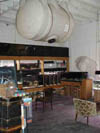

|
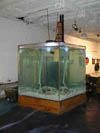 |
I met William Basinski (Billy) of Arcadia as he was opening the door to his showroom. He was polite and funny, apologizing for being late. Billy described his work as "concepts for living," including film/video production, sound and interiors. There was an eclectic array of items for me to touch, as I tend to do, including furniture that was neither refined nor completely awkward, but peculiar and engaging nonetheless--and a looped video that made me pleasantly sleepy. I have to hand it to Billy; he has a good eye for the unusual. This would be a great place to have a party. Of equal interest to me, however, was the architecture of the Arcadia loft. The ceilings are vaulted in a star-like configuration, which was the innovation of designer Nils Poulsen, founder of Hecla Ironworks in 1888. He held a patent on an "octagonal fireproof building design" that combined cast iron and plaster. It's absolutely beautiful, I've never seen anything quite like it, and I have considered it at length while passing the windows on the street below. The building served as Hecla's showroom and drafting facility while it was operational. Unfortunately, Nil's' window of opportunity for cast iron and plaster interiors never quite got off the ground, as I understand it. |
  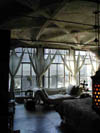 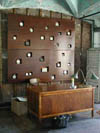 |
|
I have never been much of car guy, but I was taken with Subtexture's "spin" on the matchbox-styled cars of yesteryear in Slot Racer Fury--the electric racetrack with the pistol-grip controls. Remember? They're the ones that always jump the track before you finish a lap. Well, his tribute to the slot car phenomena combined blueprint drawings of pieces and parts of the whole, very simple illustrations like those that would appear in the directions. With actual slot car tracks set up to race on special tables and directly on the floor, I felt like I was over at a friend's house to play. Subtexture created a real sense of slot car mania. The effect was complete with graphically challenged slot car racer fluorescent light fixtures, dangling precariously above each of the racing outposts. Subtexture's tagline is "visual problem solving for a dyslexic society--an apt description of the whole scene. Although I liked the attention to detail and the ambitious art happening/installation quality of the setup, I was also taken with these pretend cookie-shaped resin castings that had their own special display table. What exactly are these? The slot racer stickers, press releases, and drawings leading up to this self-imposed event, along with the crowd of anxious race fans with beer, made this a full-blown experience. |
   |
|
Perfect Circle Metalwork was a nice opportunity to see one of the many fabrication shops that are doing interesting work. They do high-end fabrication and are also developing designs of their own to manufacture. This event was a great opportunity for small shops like this one to meet-and-greet potential work. It was also invaluable for designers and future specifiers to see what a shop is set up to do. These guys fabricate with weapons-grade precision, (at least the stainless steel kitchen island I saw was weapons), and I look forward to seeing what they do in the future with their own designs. Another plus: their steel fabrication tables convert to a ping-pong table, complete with welding clamps on the underside for easy storage. And I know that if I had had more time, I would have swiftly beaten Peter at his own game. |

|
Crypto is one of several stores that helped make the Northside of Williamsburg into a delighted-consumer's shopping extravaganza. The boutique made their big splash several years back with digital graphic image bags, and now carries a mélange of other coveted items. Embracing good design with a nod to the fashion conscious, this retailer embodies the nuances of the neighborhood, with a distinctly post-East Village style that began here in Williamsburg.  

|
 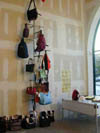 |
|
I have been intrigued with One Sixty Glass since they opened their doors a couple of years ago. I lived in Seattle (one of the glass blowing capitals of the world, and home to the infamous Dale Chihuly) while attending Graduate School. I learned through association that glass blowing is both difficult and labor intensive, requiring tremendous patience. Besides, it's really, really hot. Above all, a glass studio is a very expensive operation to set up and maintain. That style of tenacity was personified in all the studios throughout the weekend. Surely there's an easier and more cost-effective place to set up a shop. Why in New York? The answer is probably that they want to be where the action is, and One Sixty seems to be getting a lot of play. There was a glass-blowing demo while I was there. The room was packed with onlookers and dead silent, except for the rush of the blast furnace and less-than-ambient background music. I think everyone was entranced, staring at the red molten glass like a campfire. The studio makes mostly functional glassware that looks great, with a hand-blown quality not available in production glass. And they sell it right out of the shop. They are currently offering glassblowing classes that seem like a bargain. |
 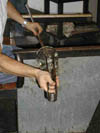 |
|
Elseware, a self-described ID collective, works together to develop a new creative outlet--for themselves. It's like a 12-step design program. There's a playful quality to the methods and materials of these five designers, and that is apparent in the work. I think that Elseware has some pretty fun (and funny) ideas. Clearly, they are keeping themselves and others entertained. I find the most interesting part, however, to be their commitment to organizing and participating in theme-based exhibitions and installations. They are time-consuming and expensive, but they are great to attend--and participate in! Elseware had several new products and a few of their old standards on display. I liked the Soap on a Rope, a self-promoting dog tag on a chain embedded in a cylindrical blob of fragrant soap. I have one dangling in my bathroom at home, and I have no idea where I got it. Also noteworthy is a functional toilet with a clear acrylic fish tank at the back...complete with a bubbler for the fish. There's also a fluorescent light fixture that uses a foot pump to lower and raise the bulb, employing the body of the fixture as the diffuser. I like this work, and look forward to a new collection of fun and inventive products in the future--and more theme-based exhibitions. 

|
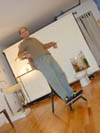 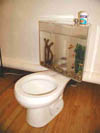 |
LD5 is named for their current building entrance on loading dock # 5 off of Kent Avenue, one of the main thoroughfares in Williamsburg. It is an exciting firm whose members are passionate about architecture. They are doing pure architecture, mostly in Brooklyn, and have been focused on several large-scale projects, which are designed to reinvigorate the architectural spaces in the area. Williamsburg and, consequently LD5, are poised to receive some work as Williamsburg's waterfront is redeveloped in the near future--LD5 is going to be there to make sure that the buildings are designed and engineered with care, and character. Those who claim that too much variety makes it difficult to maintain a steady focus--and that too much information confuses the public--will take a sharp lesson from this trio. There is very little that nydr does not engage creatively, and with a decent success rate. From fashion to architecture, products/objects, and even books, this studio group is multidisciplinary, to say the least. |
|
A little further south is nydesignroom. Maintaining a stylistic logic and appearance consistent with the vision for their offices, this showroom features their own designs as well as some vintage items. Of particular interest is clothing that has been made from some recycled pieces of material. Although I was unable to attend their event, I was told repeatedly that the trash-a-porter: Red Star Fall Collection at Roebling Hall was one of the highlights of the weekend. I anxiously await their next fashion happening. 

|
  |
Located on the South side of Williamsburg is High Valley Books. With a focus on fashion, interior decorating and design, this is one of those local treasures whose charm and access are only available via word-of-mouth--and by appointment only. I was half-tempted to buy the entire collection of publications by David Hicks: from the On Decoration series to Living with Design. These are practically textbooks for designers, and I wanted them all. We had a discussion about a great old magazine, long out of print now, called Horizons. He immediately told me where I could find them in the city, and how great he thought they were. We're lucky to have such a resource in Williamsburg. I have watched with great anticipation as the scale and quality of the interior projects in Williamsburg have increased over the past few years. It is no longer acceptable to have a "thrown-together" shop in the Burg, as was business-as-usual several years back. Chalk it up to a design-savvy community, but weeve projects was right there to make sure that it was done correctly. They have a lot of ambitious projects under their belts, completed in only a few short years. In addition to the Wythe Studios Building on Wythe Avenue, their newest creation is a little further north. Red & Black is a three-part club, complete with fireplace in the front and dance area in the rear. weeve is also doing their part to encourage community involvement and responsible development in Williamsburg. Sooner or later, you will find yourself shopping or having a beer in a weeve project. |
|
|
I have no command for fashion, as evidenced by my day-to-day wardrobe, but I was intrigued by the primitive designs and the rogue methods in which Ashley Tyler chooses to display her SPYNE collection. By staging commando fashion shows, she literally makes people come in contact with her work. That's probably all it will take to get her work noticed, as the designs I saw at her space were convincing in and of themselves. There is a quality to them, something primordial, yet accomplished and elegant. As I understand it, she will stage a commando runway show on the tail end of a more high-profile event, thereby recapturing the audience and imposing her aesthetic on them. The rawness of hand-braided silk, coupled with the elegant drape of the same material, was very enchanting. They almost resemble dread locks or hand-woven ropes adorning a very simple cut of cloth. Several variations in the line, which played on this theme, were of interest. In addition, there was a coat or a poncho (I couldn't tell which for sure)--stylized hides with crude antler or bone closures, all fascinating. I would describe the work as Conan the Barbarian meets Halston. SPYNE appealed to my most basic feelings about clothing and how it functions, while maintaining a clear vision and consistency in its look. I like to sew, I admit it. I even have my own beat up Singer machine stashed at my studio. I discovered my Mom's cross-stitching supplies at an impressionable age, and took to crafting trees, ponies and angels-in-flight on a small grid. The Yarn Tree reminded me that I still harbor a secret desire to engage such labors, and I'm mad as hell that I missed the knitting demo. They offer a wide range of supplies for crochet and knitting and, I might add, they do not carry acrylic yarn--only the natural stuff. Don't even bother asking. They are purists in every sense, and they are committed to the craft. No more traveling to Pearl Paint for your knitting supplies. |
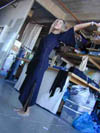
|
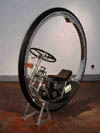 When I run across something in a gallery that appeals to me, I spend a little extra time there. I had that experience the other day, at the Sideshow Gallery. The exhibition: Ultra Deluxe. How great is that? Forrest Myers and Michael Talley (working in collaboration with Elizabeth Cohen) have produced several objects that will appeal to artist and designer alike. The show is about obsession with vehicles. Occupying the bulk of the main space are two such obsessive vehicles, both equally absurd, but in different ways. One of two sculptures Myers has produced for the installation is called Unocycle, a one-wheeled street legal motorcycle. It is essentially a giant wheel surrounding a retrofitted cycle--it's not only improbable that it will be ridden on the street, it's unlikely that it will ever be ridden at all. If one were to ride it, it would be in an endlessly circular path. It's a kind of self-reflexive question, evoking pure curiosity. It's funny, but in a ponderous way.
When I run across something in a gallery that appeals to me, I spend a little extra time there. I had that experience the other day, at the Sideshow Gallery. The exhibition: Ultra Deluxe. How great is that? Forrest Myers and Michael Talley (working in collaboration with Elizabeth Cohen) have produced several objects that will appeal to artist and designer alike. The show is about obsession with vehicles. Occupying the bulk of the main space are two such obsessive vehicles, both equally absurd, but in different ways. One of two sculptures Myers has produced for the installation is called Unocycle, a one-wheeled street legal motorcycle. It is essentially a giant wheel surrounding a retrofitted cycle--it's not only improbable that it will be ridden on the street, it's unlikely that it will ever be ridden at all. If one were to ride it, it would be in an endlessly circular path. It's a kind of self-reflexive question, evoking pure curiosity. It's funny, but in a ponderous way. The larger piece that Michael and Elizabeth are exhibiting is called Adrenaline. A racer crafted from the drop tank of a fighter jet, it looks just like a combination between a missile and a Soap Box Derby car. You may have also seen Michael's work over at Firebrand, where he is a partner in this product/interior design firm. Well, it turns out that this racer was designed to run on the Salt Flats in Utah. Although great care and attention has been paid to the engineering of this vehicle, its paint job is rustic and militaristic in drab olive green--perhaps intended to make it appear to be a functional racer. Is this vehicle functional? I'm not sure, and I think the possibilities are more exciting when it's not clearly defined. Different in its approach, Unocycle is functional and makes sure that you know it--attention has been paid to making sure that it was not transformed from a motorcycle that we would all recognize as such. Both artists grew up on the West Coast and were interested in building hot rods. Myers used to bike to "Big Daddy" Roth's shop and watch the cars get tricked out--paintjobs and detailing by the best in the business. Ed Roth is considered the grandfather of hot rod detailing, producing the most fiercely cherry cars on the planet in his day. Both objects address the same conceptual issues: desire, longing, and bravado, as well as attention to perfect detail, but they employ very different visual methods to make their point. These are designs about the nature of sculpture and how an object functions--they are also sculptures about the very nature of design. I thoroughly enjoyed the show. |
|
While I can't say with confidence that I would have understood their mission without having spoken to the founders, Eidia House (pronounced idea house) is committed to the realization of ideas, utilizing an approach referred to as R-4: reduce, reuse, recycle, and renew. Paul and Melissa are proponents of deconsumption, and they want us to think about changing our approach to the exploitation of the objects that are already in the world. They are interested in regenerating universal ideas that occur in art and design, while exercising a little restraint with the amount of material production that takes place in pursuit of these ideas. I think that this is worth some serious consideration. Little is said about the long-term problems associated with mass-production, particularly when the room is filled with designers. In an industry such as ours, success is often measured by how many of something one is able to produce and distribute for the least amount of money. Consumption is good, right? This premise rarely takes into consideration how that object will spend the next one hundred or even one thousand years in a landfill, long after it is no longer desired or needed. 

|
   |
|
K-Boom has a limited furniture line and several pieces of handmade clothing. This tiny venue made me laugh with its acrylic coffee table, complete with acrylic biscuits used in the construction of the piece. The entire table is a riff on the way things are typically constructed; it's a joke that a designer will get, or anyone who has ever worked in a woodshop. They are planning several additional designs that incorporate the same "biscuiting" strategy. Looking forward to seeing them. Tip of the day: they sell handmade acrylic rings that they are practically giving away. |
|
|
I've been to just about every gallery in New York, and I can say with honesty that one of my favorites is Roebling Hall. I always walk in and see something that engages me on some level, and I think that's a pretty tall request for most of us. This last time was no exception. While providing space for nydesignroom's trash-a-porter Fall Collection debut, the gallery had work installed that, by sheer accident, relates to many of the same issues that surround fashion design. The show by Beth Campbell, entitled "Same as Me," was about issues of sameness and differentiation--the place where individuality and just-one-of-the-crowd overlap, and then diverge. In a society that continues to grow more and more homogeneous, I think this is a complex idea to explore, and the work projects an air of confidence. Included in the show are still photographs and video projection. The stills reflect common vignettes of everyday life, but slightly tweaked using beauty products to do so. As an example, there might be a vanity table with multiple skin moisturizer bottles, carefully arranged in a row. Seemingly innocuous, they pack a punch, if you give it all some consideration. Beauty products are, by design, intended to complement the wearer by making them look more attractive and distinctive, helping that person to create their own individual look. The irony is that these products are being mass-produced and distributed to millions of people, marketed in exactly the same way to everyone in order to achieve the same individual effect. It's very interesting territory for the artist, and I think the work was very successful. |
   |
Not afraid to bear it all, the boys from Touch Design Studio were happy to camp out, more or less, in the entryway of the LANDING building. Bold move, yet somewhat humbling. I think that's a good place to be. I like their stuff, it's simple and direct. Ghost, a coffee table, is in the form of a square tablecloth draped over a round table, sans the table. The effect is that of an Ouija Board party...the shape of the tablecloth appears to float. I also like splash/ripple, a cereal bowl and liner combination that takes the form of the famous photograph of a single drop of milk splashing. Nice. 

|
 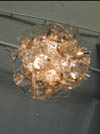 |
|
In an attempt to dispel any myths about the name of this post-production studio, I assured the kids over at Milo that I would clear it up. Milo was the name of one of the founder's favorite aunts, not the character from the Doonesbury comic strip. Although post-production is something we hear about every day, it remains a bit of a mystery to me. When people say, "I work in post-production," I really don't know what that entails. I'm just glad that my TV favorite shows look and sound as good as they do. In any case, the team was busy editing some video shot during the construction of their office. They were throwing a party to celebrate one year of keeping the doors open. And that's an achievement in and of itself. They sure were enjoying themselves and the work they were doing. I always think that's a really good sign, when people like what they do--and get paid. | |
|
Blake Moore is a former principal designer with Girth Design. He lives and works in Williamsburg. |
|
|
>> back to top >> back to core |
|